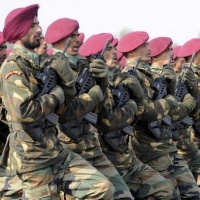|
#2
November 4th, 2017, 03:33 PM
| |||
| |||
| Re: Indian Army Soldier in Camouflage
The cutting edge Republic of India (भारत गणराज्य) was conceived in 1947 after a peaceful battle for freedom from Great Britain. Following the disintegration of the British Indian Empire, the country of Pakistan was framed out of domains with a Muslim lion's share, leaving more than 10 million dislodged individuals compelled to relocate towards either of the new countries. The two countries have been to war twice (in 1947 and again in 1965) over the region of Kashmir, and India likewise went to the guide of the Mukti Bahini amid the Bangladesh War of Liberation (which finished in the making of Bangladesh). Relations amongst India and Pakistan keep on being endured best. India keeps up the third-biggest military power on the planet, and is a regular member in United Nations peacekeeping endeavors the world over. The Armed Forces of India incorporate the customary Army, Navy and Air Force, the Coast Guard, the Strategic Forces Commando (Nuclear Command) and the Paramilitary Forces of India (PFI). The last comprises of the Central Police Organizations (counting the State Armed Police, Central Reserve Police Force, Rapid Action Force, the Indian Home Guard, Civil Defense, and a few master units), and the Central Paramilitary Forces (counting Border Security Force, Indo-Tibetan Border Police, Special Frontier Force, and a few different offices). The dominant part of units of the Indian Armed Forces wear disguise in some shape, many having designs particular to their specific Force or gathering. A few Regiments inside the Army additionally utilize their own one of a kind examples. The standard cover of the Indian Armed Forces is called Disruptive Pattern Material (DPM) despite the fact that it has no relationship at all to the British disguise outline of a similar name. India has an expansive material and piece of clothing industry, providing its own particular military needs as well as sending out texture and regalia to different countries too. Indian Camouflage Patterns Conceivably as ahead of schedule as the 1960s, India started recreating the British-planned brushstroke cover design for use by its own Airborne and Para-Commando troops. The example kept on being utilized by these units into the 1970s and is obviously still observed every so often among paratroopers on their airborne frocks. A few shading varieties have been archived, a component that isn't at all abnormal with Indian made materials. Refreshed adaptations of this example are as yet being worn by Indian Para-Commando powers. The example that has come to be known as Indian DPM has no relationship to the British outline of a similar name. It is a covering example of green and darker palm leaf shapes on a khaki foundation, in spite of the fact that there is a gigantic inconstancy from light to exceptionally dull. All way of uniform styles have been created in this example, and additionally a few bits of field hardware. The example is regularly called "palm frond" or "Indian leaf" design.  |